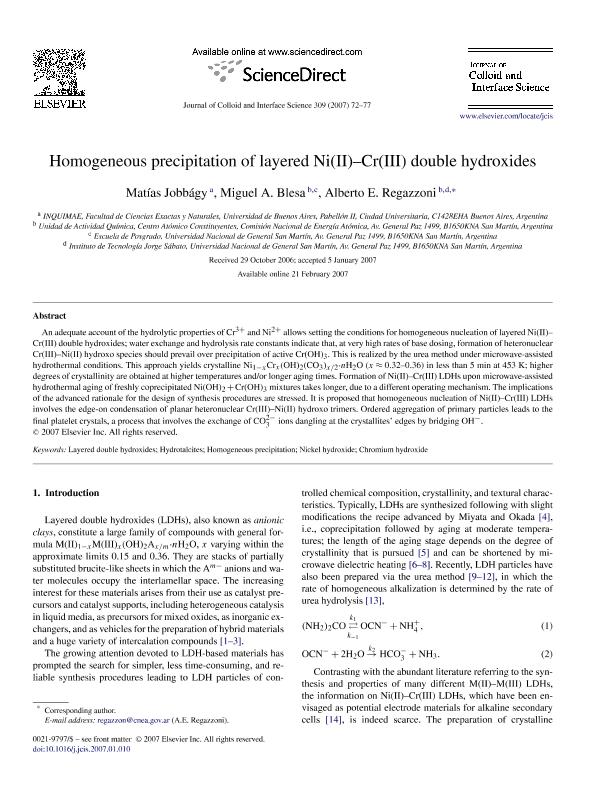Mostrar el registro sencillo del ítem
dc.contributor.author
Jobbagy, Matias

dc.contributor.author
Blesa, Miguel Angel

dc.contributor.author
Regazzoni, Alberto Ernesto

dc.date.available
2020-04-17T20:06:45Z
dc.date.issued
2007-05
dc.identifier.citation
Jobbagy, Matias; Blesa, Miguel Angel; Regazzoni, Alberto Ernesto; Homogeneous precipitation of layered Ni(II)–Cr(III) double hydroxides; Academic Press Inc Elsevier Science; Journal of Colloid and Interface Science; 309; 1; 5-2007; 72-77
dc.identifier.issn
0021-9797
dc.identifier.uri
http://hdl.handle.net/11336/102966
dc.description.abstract
An adequate account of the hydrolytic properties of Cr3+ and Ni2+ allows setting the conditions for homogeneous nucleation of layered Ni(II)–Cr(III) double hydroxides; water exchange and hydrolysis rate constants indicate that, at very high rates of base dosing, formation of heteronuclear Cr(III)–Ni(II) hydroxo species should prevail over precipitation of active Cr(OH)3. This is realized by the urea method under microwave-assisted hydrothermal conditions. This approach yields crystalline Ni1−xCrx(OH)2(CO3)x/2·nH2O (x ≈ 0.32–0.36) in less than 5 min at 453 K; higher degrees of crystallinity are obtained at higher temperatures and/or longer aging times. Formation of Ni(II)–Cr(III) LDHs upon microwave-assisted hydrothermal aging of freshly coprecipitated Ni(OH)2+Cr(OH)3 mixtures takes longer, due to a different operating mechanism. The implications of the advanced rationale for the design of synthesis procedures are stressed. It is proposed that homogeneous nucleation of Ni(II)–Cr(III) LDHs involves the edge-on condensation of planar heteronuclear Cr(III)–Ni(II) hydroxo trimers. Ordered aggregation of primary particles leads to the final platelet crystals, a process that involves the exchange of CO32− ions dangling at the crystallites’ edges by bridging OH−.
dc.format
application/pdf
dc.language.iso
eng
dc.publisher
Academic Press Inc Elsevier Science

dc.rights
info:eu-repo/semantics/openAccess
dc.rights.uri
https://creativecommons.org/licenses/by-nc-sa/2.5/ar/
dc.subject
Layered double hydroxides
dc.subject
Hydrotalcites
dc.subject
Homogeneous precipitation
dc.subject
Nickel hydroxide
dc.subject
Chromium hydroxide
dc.subject.classification
Físico-Química, Ciencia de los Polímeros, Electroquímica

dc.subject.classification
Ciencias Químicas

dc.subject.classification
CIENCIAS NATURALES Y EXACTAS

dc.title
Homogeneous precipitation of layered Ni(II)–Cr(III) double hydroxides
dc.type
info:eu-repo/semantics/article
dc.type
info:ar-repo/semantics/artículo
dc.type
info:eu-repo/semantics/publishedVersion
dc.date.updated
2020-04-17T14:39:45Z
dc.journal.volume
309
dc.journal.number
1
dc.journal.pagination
72-77
dc.journal.pais
Estados Unidos

dc.description.fil
Fil: Jobbagy, Matias. Consejo Nacional de Investigaciones Científicas y Técnicas. Oficina de Coordinación Administrativa Ciudad Universitaria. Instituto de Química, Física de los Materiales, Medioambiente y Energía. Universidad de Buenos Aires. Facultad de Ciencias Exactas y Naturales. Instituto de Química, Física de los Materiales, Medioambiente y Energía; Argentina
dc.description.fil
Fil: Blesa, Miguel Angel. Universidad Nacional de San Martín; Argentina. Comisión Nacional de Energía Atómica. Centro Atómico Constituyentes; Argentina. Consejo Nacional de Investigaciones Científicas y Técnicas; Argentina
dc.description.fil
Fil: Regazzoni, Alberto Ernesto. Universidad Nacional de San Martín. Instituto Sabato; Argentina. Consejo Nacional de Investigaciones Científicas y Técnicas; Argentina. Comisión Nacional de Energía Atómica. Centro Atómico Constituyentes; Argentina
dc.journal.title
Journal of Colloid and Interface Science

dc.relation.alternativeid
info:eu-repo/semantics/altIdentifier/url/https://www.sciencedirect.com/science/article/abs/pii/S0021979707000343
dc.relation.alternativeid
info:eu-repo/semantics/altIdentifier/doi/http://dx.doi.org/10.1016/j.jcis.2007.01.010
Archivos asociados
